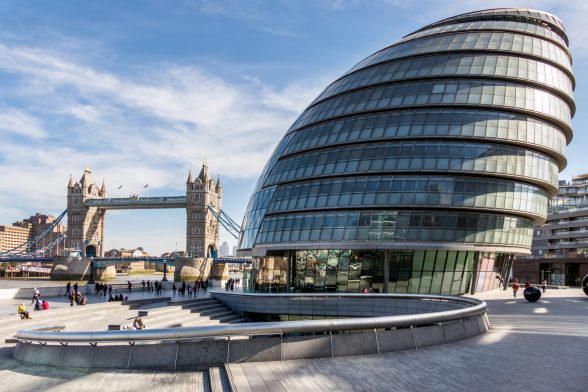This website uses cookies
This website uses cookies to enable it to function properly and to analyse how the website is used. Please click 'Close' to accept and continue using the website.


City Hall, London

Image: Shutterstock
City Hall has been the official home of the Greater London Authority since it was opened by the Queen in 2002 and occupies a prominent position on the south bank of the Thames. Designed by Foster & Partners with Arup as the structural engineers, it has a distinctive slanting ovoid shape, created by inclined perimeter columns. A 500m helical walkway, which defines the interior, spirals up through the full-height atrium space.
The starting point for the project, according to Foster’s Ken Shuttleworth, was to reduce the energy load of the building by 75 per cent and this determined the building’s shape which achieves optimum energy performance by minimising the surface area exposed to direct sunlight. Significantly, its design was reported to have been inspired by the practice’s earlier work rebuilding the Reichstag in Berlin, with the idea of a transparent government, open and accessible to Londoners, who should be able to watch the assembly. The GLA has leased the building from a private landlord – the Kuwaiti-owned St Martin’s Property Group – at a cost of more than £11m a year.
The mayor Sadiq Khan is moving the GLA to a new HQ in the east of the city, which is expected to generate savings of more than £60 million over the next five years. The C20 Society is concerned about the building’s future and submitted an application to list at Grade II* ‘as a major piece of 21st-century public architecture, built for the newly-created Greater London Authority by an internationally renowned architectural practice.’ This was immediately rebuffed by Historic England which said “Although we acknowledge your concerns about the future of the building once the Greater London Authority moves out, this does not constitute a serious threat of demolition or major alteration at this time’ adding that it is not clear that City Hall has strong potential for inclusion on the NHLE (National Heritage List for England). Buildings under 30 years old rightly have to meet stricter criteria than older ones, but waiting until time and money has been spent on destructive plans before HE even considers listing helps no one and risks jeopardising our youngest heritage.

Become a C20 member today and help save our modern design heritage.